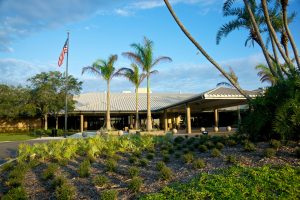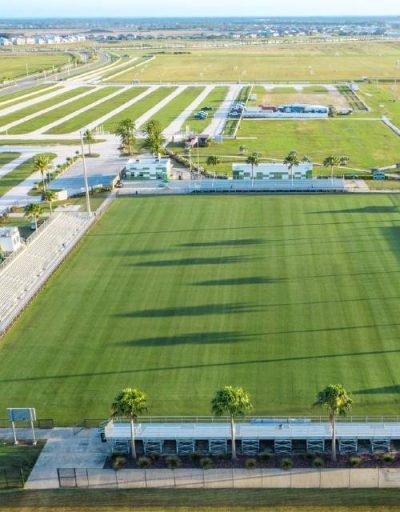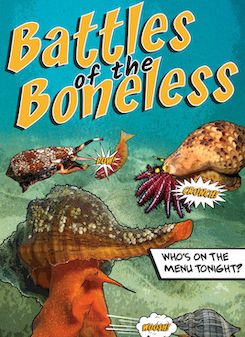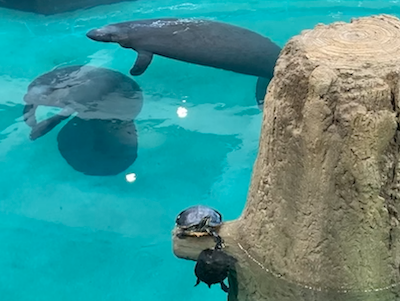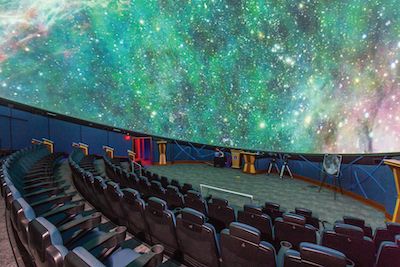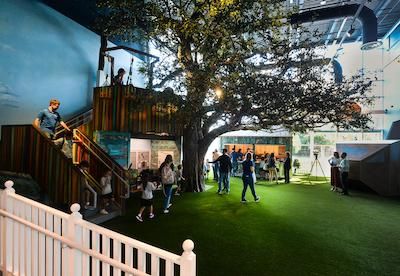What’s New at the Bishop Museum of Science & Nature
Most people think about museums as places housing thousands of lifeless artifacts from days gone by. Obviously, those people have never been to the Bishop Museum of Science and Nature. Not only is it alive with wonder, but it’s also the home of a real-life manatee rehabilitation center and the largest planetarium on Florida’s west coast—with a new state-of-the-art projection system that brings real-time images of astronomical phenomena. It’s here we spoke with Remi Gonzales, the Director of Communications and Brand, to discover everything that’s new (living and otherwise) at The Bishop.
Bam! Pow! Slurp?
One of the newest exhibitions that just debuted this month is The Battle of the Boneless, a “comic-book themed” exhibition that explores the adaptations—which are essentially superpowers for snails—that have allowed mollusks to become one of the largest and most diverse animal groups on the planet.
“Normally, you think of snails as just pretty shells that you find on the beach,” Gonzalez explains. “But they are actually really cool, complex animals.”
For example? “Some of them have venomous saliva. Some of them drill into the shells of their prey and slurp up on the inside. Some of them have built-in harpoons that they use to snag fish and bring them in to eat them,” she enumerates. “So, I think there’s a lot of surprises here for people to really get a feel for the secrets of snails and the battles that are going on under the ocean.”
The Battle of the Boneless is located in the Museum’s East Gallery. Visiting is included in the price of your admission.
Meet our manatees (and turtles too!)
Also newly reopened at The Bishop just last month is extensively renovated Parker Manatee Rehabilitation Habitat, where sick and injured manatees are nursed back to health. According to Gonzalez, the newly renovated Habitat resembles a cypress spring, which provides the manatees with a more naturalistic environment that closely mimics what they will encounter in the wild.
Some of the changes include the addition of an artificial tree that the manatees can navigate around and varying levels and depths that they can explore and rest upon, with surfaces that are scratchier and sandier than before, so the manatees can exercise their sense of touch.
“What we found is the two manatees in our care now really enjoy sleeping with their tails up against the trunk of the artificial tree,” Gonzalez explains. “They’re very tactile. They like to walk along on their flippers, and they like to just scratch against surfaces. So that scratchy surface at the bottom is really good for them.”
“The other thing that’s new about the pool, and I think this is the coolest thing, is that we now have turtles with the manatees,” Gonzalez says. There are two, she observes. One for each manatee. “Our director of animal care felt very strongly that we could make the environment even more enriching for the manatees and the turtles too to put them together,” she describes.
The Parker Manatee Rehabilitation Habitat is what’s known as a Stage 2 rehabilitation facility—a temporary home where manatees come after their initial critical care needs have been met in manatee hospitals. This exhibition allows above and underwater viewing and offers information about the anatomy and life history of manatees and sea turtles, including the challenges they face in the wild.
Universal appeal
The Planetarium at The Bishop is a remarkable astronomy education resource that allows you to explore the universe through immersive virtual journeys to the far reaches of the cosmos.
“More than 100% of our visitors go to the planetarium,” Gonzalez states. “Which means that our visitors are seeing more than one show. People just love the planetarium,” she adds. “And they love our staff astronomer.”
That man is Planetarium Manager Howard Hochhalter, whose own interest in astronomy began, where else, but inside the darkened confines of a planetarium. There he marveled at the scale and majesty of the cosmos. It led him on a lifelong pursuit of knowledge of science and the universe, knowledge he loves impart (and inspire) with others.
“Howard is extremely good at taking really complex astrophysical things, and giving examples, so people can understand and relate it to their own life, which is a rare gift, really,” Gonzalez says.
And thanks to The Planetarium’s new state-of-the-art projection system and software—that’s 1½ times brighter than our previous system and has four times the contrast—Hochhalter can help you see into the deepest depths of the cosmos and understand it better than ever before.
Play in our backyard
Another new-ish addition to The Bishop (it opened in September 2019) is the Mosaic Backyard Universe, Southwest Florida’s coolest backyard playground.
The new Mosaic Backyard Universe is fully ADA accessible and designed for kids of all ages, and grown-ups who are young at heart. Complete with scale models of the solar system, a freshwater pond filled with turtles and a Mighty Oak that towers above it all, the Mosaic Backyard Universe is a safe, fun and familiar environment to foster curiosity and exploration in science and nature.
According to Gonzalez, it’s home to one of the museum’s coolest curiosities: A giant skull. “It looks like it could be a skull of something related to a rhino,” she describes, adding. “And in fact, it is. It’s called a Brontothere. And what is so cool about that skull is that, first of all, it’s huge. And second, it was found by one of the teachers here in Manatee County, who we took on our annual Nebraska fossil dig to the Badlands.
Discover what’s new for yourself
When asked what she hopes people will take away from all the new additions, Gonzalez doesn’t hesitate: “We want people to say, ‘Wow! I didn’t know that. I learned something. That is fascinating,’” she answers immediately.
“We really want to light people’s curiosity and love of discovery and exploration. That’s why we’re here.”



